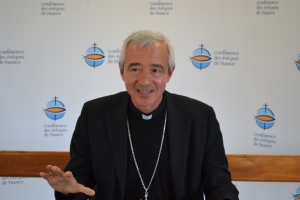 Through Archbishop Jorge Carlos Patrón Wong, Rome has revealed a minimal number of seminarians that a seminary needs to be “a veritable training community”, La Croix reports. The most recent Ratio Fundamentalis Institutionis Sacerdotalis, the document outlining the guidelines for the formation of future priests, did urge that seminaries need to be of sufficient size to function as a community in which priestly formations could flourish and develop, it refrained from mentioning an actual number. Last Monday, in a meeting with the bishops of France, Archbishop Patrón Wong, the secretary for seminaries of the of the Congregation for Clergy, reiterated this guideline, but left it to Bishop Jérôme Beau, auxiliary bishop of Paris, to state a minimum number of 17 to 20.
Through Archbishop Jorge Carlos Patrón Wong, Rome has revealed a minimal number of seminarians that a seminary needs to be “a veritable training community”, La Croix reports. The most recent Ratio Fundamentalis Institutionis Sacerdotalis, the document outlining the guidelines for the formation of future priests, did urge that seminaries need to be of sufficient size to function as a community in which priestly formations could flourish and develop, it refrained from mentioning an actual number. Last Monday, in a meeting with the bishops of France, Archbishop Patrón Wong, the secretary for seminaries of the of the Congregation for Clergy, reiterated this guideline, but left it to Bishop Jérôme Beau, auxiliary bishop of Paris, to state a minimum number of 17 to 20.
While Bishop Beau conceivably arrived at this number from a French perspective (in that country, only fifteen of the thirty-two seminaries reach the minimum of seventeen seminarians), it could have repercussions for other countries as well.
The Vatican guidelines make no demands about numbers, merely inviting bishops’ conferences to “consider” a minumum number for seminaries to remain open, and Archbishop Patrón Wong seemingly expressed his personal opinion that seminaries who do not manage to reach that number should be closed or merged.
Should the Congregation for Clergy move from an urging to a demand, what would the consequences for the Dutch dioceses and seminaries be? A question that is especially interesting considering the question that flares up every now and then of whether the Dutch seminaries shouldn’t merge anyway.
There are currently seven seminaries and other places for the training of future deacons and priests in the Netherlands: The Ariënsinstituut in Utrecht, St. Willibrord seminary in Heiloo (Diocese of Haarlem-Amsterdam), Vronesteyn in Voorburg, (Diocese of Rotterdam), Bovendonk in Hoeven (Diocese of Breda), St. John’s Centre (Diocese of ‘s-Hertogenbosch) and Rolduc (Diocese of Roermond), as well as two seminaries of the Neocatechumenal Way, in Cadier en Keer (Roermond) and Nieuwe Niedorp (Haarlem-Amsterdam). Most of these already cooperate closely, with teaching staff working at several seminaries and seminarians from various dioceses living and working in one place. Bovendonk caters especially to late vocations, offering a curriculum for students that is compatible with their day jobs.
Of these seminaries there is only one which would be able to continue independently, and that is Rolduc, and then only if we combine the numbers of the diocesan seminary with that of the Neocatechumenal Way seminary, which makes sense since they already share facilities. Together, they have some 40 seminarians from 17 different countries. Only four of these hail from the Diocese of Roermond itself, while others were invited from India and Sri Lanka by Bishop Frans Wiertz. The Neocatechumenal Way seminary in Nieuwe Niedorp has 16 seminarians, just below the minimum suggested. Rotterdam’s Vronesteyn seminary has 13 students, 8 of whom study at Bovendonk and three in Utrecht. Only five seminarians live at Vronesteyn. Utrecht’s Ariënstituut has 10 students, and Haarlem-Amsterdam’s St. Willibrord seminary has 8, with one young man in a year of orientation for a future entrance. The St. John’s Centre does not offer current numbers on their website.
Merging the existing seminaries into one or two larger ones is an idea that has been floated in the past, with some staff in favour and others opposed. Merging all seminaries into one would result in a community of at least 87 seminarians. More realistically, the Neocatechumenal Way would not be involved in a merger, thus creating a seminary of between 40 and 50 seminarians. Perhaps more likely, if a merger would ever happen in the foreseeable future, there will be two seminaries with student numbers somewhere in the 20s for both.
But this is theory. For it to become reality, something more than a directive from Rome is needed. A merger would present its share of logistical and ideological problems as well, the resolution of which could initially be more divisive than unifying.
Photo credit: [1] Eglise.catholique.fr
 Bishop Jan Liesen responds to the news of the passing of Bishop Hubertus Cornelis Antonius Ernst, emeritus bishop of Breda, six weeks after celebrating his 100th birthday. The most senior of the Dutch bishops passed away late in the evening on Friday 19 May.
Bishop Jan Liesen responds to the news of the passing of Bishop Hubertus Cornelis Antonius Ernst, emeritus bishop of Breda, six weeks after celebrating his 100th birthday. The most senior of the Dutch bishops passed away late in the evening on Friday 19 May.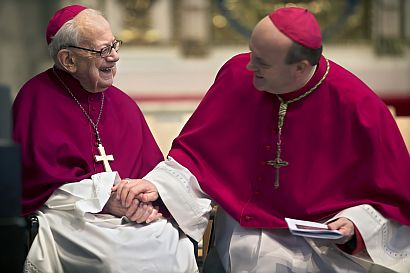 “Into very old age Bishop Huub Ernst was vital and concerned with his diocese, the Church province and society as a whole. He was consecrated as a bishop almost fifty years ago. Recently, we were able to congratulate him with his 100th birthday. Bishop Ernst was our older brother in the office of bishop, possessing a great heart for charity and the work of peace.”
“Into very old age Bishop Huub Ernst was vital and concerned with his diocese, the Church province and society as a whole. He was consecrated as a bishop almost fifty years ago. Recently, we were able to congratulate him with his 100th birthday. Bishop Ernst was our older brother in the office of bishop, possessing a great heart for charity and the work of peace.”
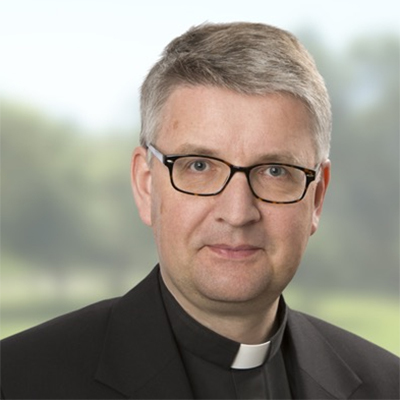 Almost a year after the retirement of Cardinal Karl Lehmann, all the dioceses of Germany have a bishop at the helm again – a situation that has not existed for several years. Succeeding the cardinal who led the Diocese of Mainz for 33 years is Father Peter Kohlgraf.
Almost a year after the retirement of Cardinal Karl Lehmann, all the dioceses of Germany have a bishop at the helm again – a situation that has not existed for several years. Succeeding the cardinal who led the Diocese of Mainz for 33 years is Father Peter Kohlgraf.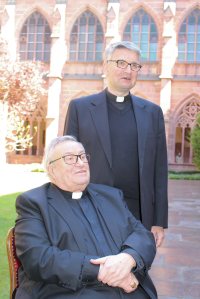
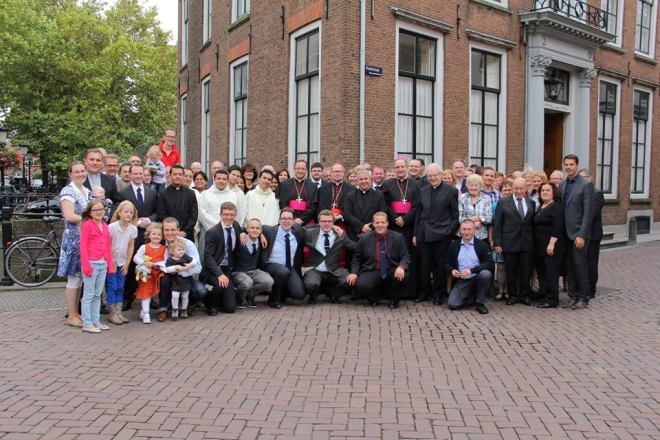 ^The seminarians for the Archdiocese of Utrecht, posing in front of the seminary house with their families and Cardinal Eijk and auxiliary bishop Hoogenboom and Woorts.
^The seminarians for the Archdiocese of Utrecht, posing in front of the seminary house with their families and Cardinal Eijk and auxiliary bishop Hoogenboom and Woorts. The eight men preparing at Bovendonk for service as permanent deacons.
The eight men preparing at Bovendonk for service as permanent deacons. The old debate about the number of seminaries in the Netherlands was restarted this week as the rectors of two of them – Fathers Jan Vries of Rolduc (Diocese of Roermond) and Gerard Bruggink (pictured at right) of the Tiltenberg (D. of Haarlem-Amsterdam) – both suggested that the Church in this country would be better served by having a single seminary for the entire Province, instead of the six that exist now.
The old debate about the number of seminaries in the Netherlands was restarted this week as the rectors of two of them – Fathers Jan Vries of Rolduc (Diocese of Roermond) and Gerard Bruggink (pictured at right) of the Tiltenberg (D. of Haarlem-Amsterdam) – both suggested that the Church in this country would be better served by having a single seminary for the entire Province, instead of the six that exist now. Most seminary rectors are in favour of merging the existing seminaries into one or two. Father Patrick Kuipers of the recently re-established Ariëns Institute (seminary building pictured at left), Archdiocese of Utrecht, says, “Personally, I am very much in favour of it. I think that the group of seminarians in the Netherlands is too small to be spread out over five or six institutes.” He thinks a group of 25 would be ideal, because that would form a true community. Father Norbert Schnell, of Bovendonk, relates that German colleagues say that 20 seminarians is the minimum required.
Most seminary rectors are in favour of merging the existing seminaries into one or two. Father Patrick Kuipers of the recently re-established Ariëns Institute (seminary building pictured at left), Archdiocese of Utrecht, says, “Personally, I am very much in favour of it. I think that the group of seminarians in the Netherlands is too small to be spread out over five or six institutes.” He thinks a group of 25 would be ideal, because that would form a true community. Father Norbert Schnell, of Bovendonk, relates that German colleagues say that 20 seminarians is the minimum required. Odd one out among the rectors is Fr. Filip De Rycke of the St. John’s Centre in Den Bosch. He admits that “sharing” teachers is a burden on people and that a larger group of students is better. But he also looks to Flanders, where all dioceses, apart from Bruges, joined forces. There is no outpouring of vocations there either, he states.
Odd one out among the rectors is Fr. Filip De Rycke of the St. John’s Centre in Den Bosch. He admits that “sharing” teachers is a burden on people and that a larger group of students is better. But he also looks to Flanders, where all dioceses, apart from Bruges, joined forces. There is no outpouring of vocations there either, he states. Led by Cardinal Eijk, some 100 faithful from the Archdiocese of Utrecht have been on pilgrimage to Rome this week. They visited various churches (Cardinal Eijk’s title church San Callisto, Saint Peter’s, the Church of the Frisians, Saint Mary Major (pictured) and Saint John Lateran), celebrated Mass at the tomb of Saint Peter, saw the sights and capped the trip off with today’s general audience with Pope Francis. Cardinal Eijk offered Mass every day in concelebration with the accompanying and some local priests.
Led by Cardinal Eijk, some 100 faithful from the Archdiocese of Utrecht have been on pilgrimage to Rome this week. They visited various churches (Cardinal Eijk’s title church San Callisto, Saint Peter’s, the Church of the Frisians, Saint Mary Major (pictured) and Saint John Lateran), celebrated Mass at the tomb of Saint Peter, saw the sights and capped the trip off with today’s general audience with Pope Francis. Cardinal Eijk offered Mass every day in concelebration with the accompanying and some local priests. Also in Breda, the pilgrims to the World Youth Day in Rio had their first reunion (pictured). They did so at Bovendonk seminary. The pilgrims looked back on the weeks in Suriname and in Rio de Janeiro, sharing their experiences with each other and with those who stayed at home to take part in WYD@Home.
Also in Breda, the pilgrims to the World Youth Day in Rio had their first reunion (pictured). They did so at Bovendonk seminary. The pilgrims looked back on the weeks in Suriname and in Rio de Janeiro, sharing their experiences with each other and with those who stayed at home to take part in WYD@Home. The Diocese of Haarlem-Amsterdam bade farewell to its vicar general, Msgr. Martin de Groot (pictured at left with Bishop Jan Hendriks), after 50 years of service in the diocese. The farewell took place with a choral evensong in Amsterdam’s Basilica of St. Nicholas followed by a reception. In addition to the diocese’s Bishops Punt, Hendriks and Van Burgsteden, Rotterdam’s Bishop van den Hende and Utrecht’s auxiliary Bishop Hoogenboom were present, reflecting the wide-ranging duties that Msgr. de Groot performed in and beyond his diocese.
The Diocese of Haarlem-Amsterdam bade farewell to its vicar general, Msgr. Martin de Groot (pictured at left with Bishop Jan Hendriks), after 50 years of service in the diocese. The farewell took place with a choral evensong in Amsterdam’s Basilica of St. Nicholas followed by a reception. In addition to the diocese’s Bishops Punt, Hendriks and Van Burgsteden, Rotterdam’s Bishop van den Hende and Utrecht’s auxiliary Bishop Hoogenboom were present, reflecting the wide-ranging duties that Msgr. de Groot performed in and beyond his diocese. Marking the abdication of Pope Benedict XVI, which becomes effective in the evening of 28 February, all Dutch and Flemish dioceses will be offering a thanksgiving Mass for his pontificate. With the exception of Haarlem-Amsterdam and Antwerp, all will do so on the day of abdication itself.
Marking the abdication of Pope Benedict XVI, which becomes effective in the evening of 28 February, all Dutch and Flemish dioceses will be offering a thanksgiving Mass for his pontificate. With the exception of Haarlem-Amsterdam and Antwerp, all will do so on the day of abdication itself. With the academic year well underway (in fact, the first break is happening this week), the numbers of new students at the Dutch seminaries have been released. With 18 new seminarians (some of whom are pictured to the left, at the Tiltenberg seminary) there is an ever-so-slight drop from last year, when 20 new names were added to the books. With several ordinations having taken place in the previous academic year, the total number of students at the four seminaries in the Netherlands remains at exactly 100.
With the academic year well underway (in fact, the first break is happening this week), the numbers of new students at the Dutch seminaries have been released. With 18 new seminarians (some of whom are pictured to the left, at the Tiltenberg seminary) there is an ever-so-slight drop from last year, when 20 new names were added to the books. With several ordinations having taken place in the previous academic year, the total number of students at the four seminaries in the Netherlands remains at exactly 100.
 Via Twitter (the social media network once again proving its value as a news disseminator) I am reading announcements that the Vatican Congregation for Bishops will announce the name of the new bishop of Rotterdam tomorrow at noon. The as yet unknown person will succeed Msgr. Ad van Luyn, S.D.B., currently serving as Apostolic Administrator of Rotterdam, as the fifth bishop of the southwestern Dutch diocese.
Via Twitter (the social media network once again proving its value as a news disseminator) I am reading announcements that the Vatican Congregation for Bishops will announce the name of the new bishop of Rotterdam tomorrow at noon. The as yet unknown person will succeed Msgr. Ad van Luyn, S.D.B., currently serving as Apostolic Administrator of Rotterdam, as the fifth bishop of the southwestern Dutch diocese.